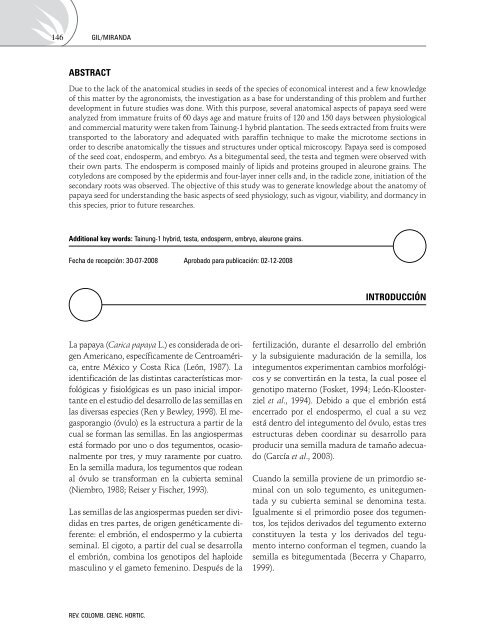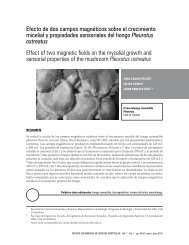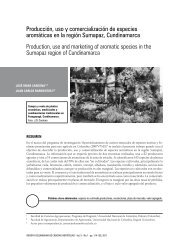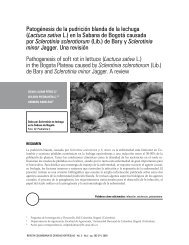Aspectos anatómicos de la semilla de papaya - Sociedad ...
Aspectos anatómicos de la semilla de papaya - Sociedad ...
Aspectos anatómicos de la semilla de papaya - Sociedad ...
Create successful ePaper yourself
Turn your PDF publications into a flip-book with our unique Google optimized e-Paper software.
146<br />
abStraCt<br />
GIL/MIRANDA<br />
Due to the <strong>la</strong>ck of the anatomical studies in seeds of the species of economical interest and a few knowledge<br />
of this matter by the agronomists, the investigation as a base for un<strong>de</strong>rstanding of this problem and further<br />
<strong>de</strong>velopment in future studies was done. With this purpose, several anatomical aspects of <strong>papaya</strong> seed were<br />
analyzed from immature fruits of 60 days age and mature fruits of 120 and 150 days between physiological<br />
and commercial maturity were taken from Tainung-1 hybrid p<strong>la</strong>ntation. The seeds extracted from fruits were<br />
transported to the <strong>la</strong>boratory and a<strong>de</strong>quated with paraffin technique to make the microtome sections in<br />
or<strong>de</strong>r to <strong>de</strong>scribe anatomically the tissues and structures un<strong>de</strong>r optical microscopy. Papaya seed is composed<br />
of the seed coat, endosperm, and embryo. As a bitegumental seed, the testa and tegmen were observed with<br />
their own parts. The endosperm is composed mainly of lipids and proteins grouped in aleurone grains. The<br />
cotyledons are composed by the epi<strong>de</strong>rmis and four-<strong>la</strong>yer inner cells and, in the radicle zone, initiation of the<br />
secondary roots was observed. The objective of this study was to generate knowledge about the anatomy of<br />
<strong>papaya</strong> seed for un<strong>de</strong>rstanding the basic aspects of seed physiology, such as vigour, viability, and dormancy in<br />
this species, prior to future researches.<br />
additional key words: Tainung-1 hybrid, testa, endosperm, embryo, aleurone grains.<br />
Fecha <strong>de</strong> recepción: 30-07-2008 Aprobado para publicación: 02-12-2008<br />
La <strong>papaya</strong> (Carica <strong>papaya</strong> L.) es consi<strong>de</strong>rada <strong>de</strong> origen<br />
Americano, específicamente <strong>de</strong> Centroamérica,<br />
entre México y Costa Rica (León, 1987). La<br />
i<strong>de</strong>ntificación <strong>de</strong> <strong>la</strong>s distintas características morfológicas<br />
y fisiológicas es un paso inicial importante<br />
en el estudio <strong>de</strong>l <strong>de</strong>sarrollo <strong>de</strong> <strong>la</strong>s semil<strong>la</strong>s en<br />
<strong>la</strong>s diversas especies (Ren y Bewley, 1998). El megasporangio<br />
(óvulo) es <strong>la</strong> estructura a partir <strong>de</strong> <strong>la</strong><br />
cual se forman <strong>la</strong>s semil<strong>la</strong>s. En <strong>la</strong>s angiospermas<br />
está formado por uno o dos tegumentos, ocasionalmente<br />
por tres, y muy raramente por cuatro.<br />
En <strong>la</strong> semil<strong>la</strong> madura, los tegumentos que ro<strong>de</strong>an<br />
al óvulo se transforman en <strong>la</strong> cubierta seminal<br />
(Niembro, 1988; Reiser y Fischer, 1993).<br />
Las semil<strong>la</strong>s <strong>de</strong> <strong>la</strong>s angiospermas pue<strong>de</strong>n ser divididas<br />
en tres partes, <strong>de</strong> origen genéticamente diferente:<br />
el embrión, el endospermo y <strong>la</strong> cubierta<br />
seminal. El cigoto, a partir <strong>de</strong>l cual se <strong>de</strong>sarrol<strong>la</strong><br />
el embrión, combina los genotipos <strong>de</strong>l haploi<strong>de</strong><br />
masculino y el gameto femenino. Después <strong>de</strong> <strong>la</strong><br />
REV. COLOMB. CIENC. HORTIC.<br />
iNtroDuCCióN<br />
fertilización, durante el <strong>de</strong>sarrollo <strong>de</strong>l embrión<br />
y <strong>la</strong> subsiguiente maduración <strong>de</strong> <strong>la</strong> semil<strong>la</strong>, los<br />
integumentos experimentan cambios morfológicos<br />
y se convertirán en <strong>la</strong> testa, <strong>la</strong> cual posee el<br />
genotipo materno (Fosket, 1994; León-Kloosterziel<br />
et al., 1994). Debido a que el embrión está<br />
encerrado por el endospermo, el cual a su vez<br />
está <strong>de</strong>ntro <strong>de</strong>l integumento <strong>de</strong>l óvulo, estas tres<br />
estructuras <strong>de</strong>ben coordinar su <strong>de</strong>sarrollo para<br />
producir una semil<strong>la</strong> madura <strong>de</strong> tamaño a<strong>de</strong>cuado<br />
(García et al., 2003).<br />
Cuando <strong>la</strong> semil<strong>la</strong> proviene <strong>de</strong> un primordio seminal<br />
con un solo tegumento, es unitegumentada<br />
y su cubierta seminal se <strong>de</strong>nomina testa.<br />
Igualmente si el primordio posee dos tegumentos,<br />
los tejidos <strong>de</strong>rivados <strong>de</strong>l tegumento externo<br />
constituyen <strong>la</strong> testa y los <strong>de</strong>rivados <strong>de</strong>l tegumento<br />
interno conforman el tegmen, cuando <strong>la</strong><br />
semil<strong>la</strong> es bitegumentada (Becerra y Chaparro,<br />
1999).








